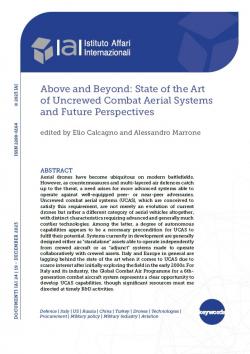Above and Beyond: State of the Art of Uncrewed Combat Aerial Systems and Future Perspectives
Aerial drones have become ubiquitous on modern battlefields. However, as countermeasures and multi-layered air defences catch up to the threat, a need arises for more advanced systems able to operate against well-equipped peer- or near-peer adversaries. Uncrewed combat aerial systems (UCAS), which are conceived to satisfy this requirement, are not merely an evolution of current drones but rather a different category of aerial vehicles altogether, with distinct characteristics requiring advanced and generally much costlier technologies. Among the latter, a degree of autonomous capabilities appears to be a necessary precondition for UCAS to fulfil their potential. Systems currently in development are generally designed either as “standalone” assets able to operate independently from crewed aircraft or as “adjunct” systems made to operate collaboratively with crewed assets. Italy and Europe in general are lagging behind the state of the art when it comes to UCAS due to scarce interest after initially exploring the field in the early 2000s. For Italy and its industry, the Global Combat Air Programme for a 6th-generation combat aircraft system represents a clear opportunity to develop UCAS capabilities, though significant resources must me directed at timely R&D activities.
-
Details
Rome, IAI, December 2023, 71 p. -
In:
-
Issue
23|24
Executive summary
1. Relevant operational trends in the use of armed uncrewed aerial systems, by Michelangelo Freyrie
1.1 The birth of armed drones and their early use
1.2 The use of armed UAS in Nagorno-Karabakh and Ukraine
1.3 Are armed UAS viable in peer-to-peer conflicts?
2. The advent of uncrewed combat aerial systems, by Elio Calcagno
2.1 UCAS and high-intensity combat: Technological hurdles
2.2 A game-changer for aerial warfare?
3. United States, by Bryan Clark
3.1 Research and development (R&D) priorities
3.2 Current programmes and UAS and UCAS fleets
3.3 Integration with crewed platforms
4. China and Russia, by Justin Bronk
4.1 Russia
4.2 China
Conclusion
5. Turkey, by Can Kasapoğlu
5.1 Military strategy, doctrine and concepts of operation (CONOPS)
5.2 Defence industrial trends: Relevant programmes (past, present and future) in terms of UCAS
5.3 Research and development (R&D) priorities
Conclusion
6. The European context, by Ottavia Credi
6.1 Main EU defence frameworks
6.2 The Eurodrone programme
6.3 The nEUROn programme
6.4 The Barracuda programme
6.5 Next steps for Europe
7. Italy, by Elio Calcagno and Alessandro Marrone
7.1 The Ministry of Defence’s approach to UAS
7.2 Italian investments on UAS technology
7.3 The GCAP opportunity and challenge
8. Conclusions, by Alessandro Marrone and Michele Nones
Acronyms



